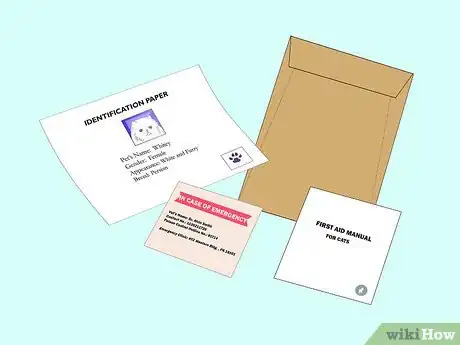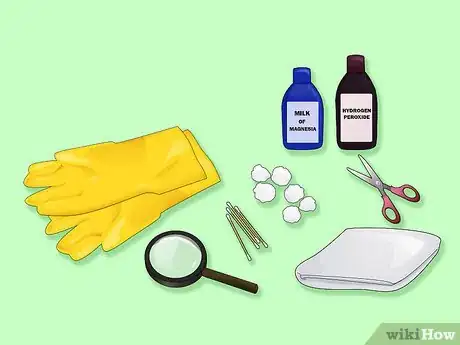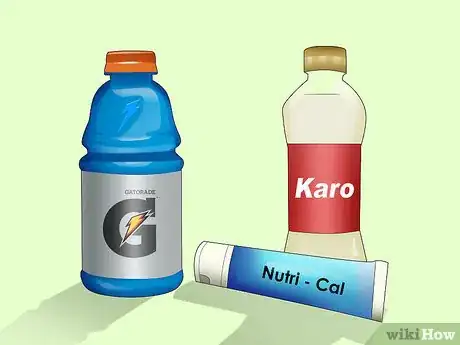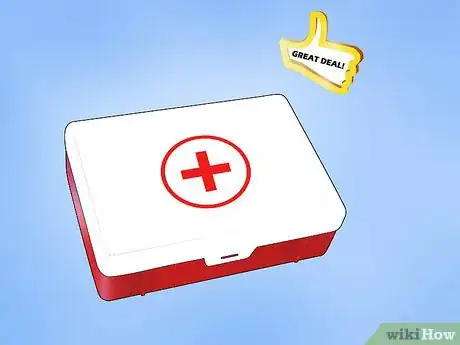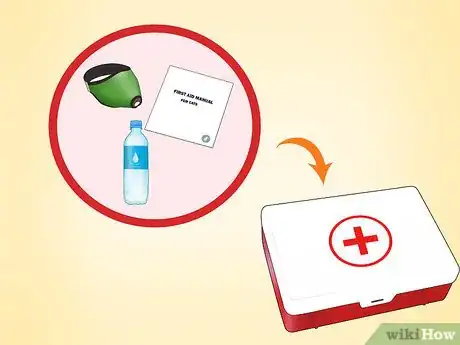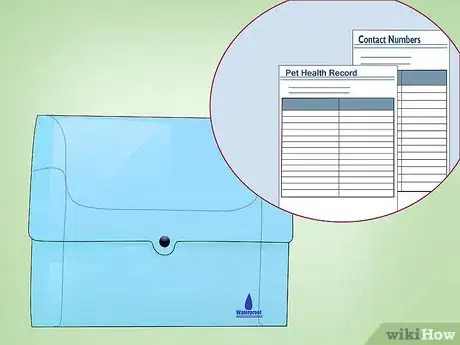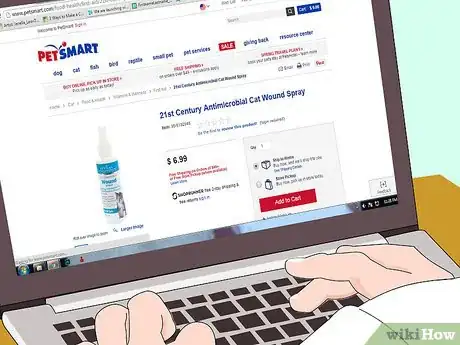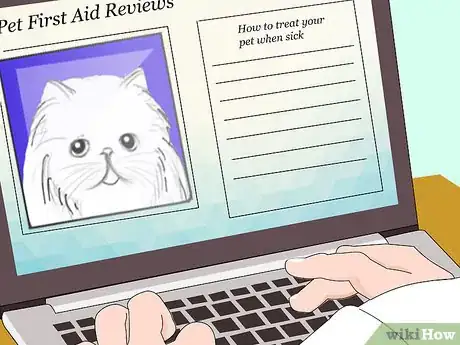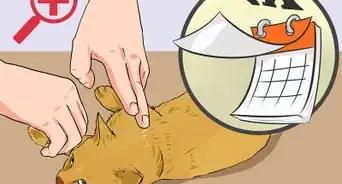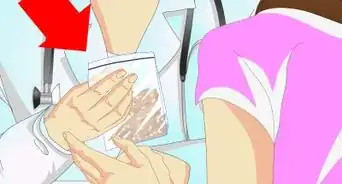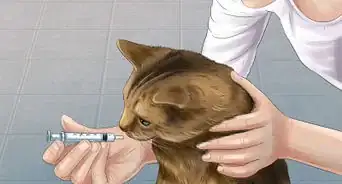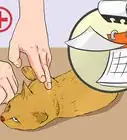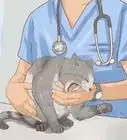This article was co-authored by Pippa Elliott, MRCVS. Dr. Elliott, BVMS, MRCVS is a veterinarian with over 30 years of experience in veterinary surgery and companion animal practice. She graduated from the University of Glasgow in 1987 with a degree in veterinary medicine and surgery. She has worked at the same animal clinic in her hometown for over 20 years.
There are 8 references cited in this article, which can be found at the bottom of the page.
This article has been viewed 10,872 times.
It’s always a good idea to be prepared. This is especially so when it comes to loved ones, including pets and felines. A great way to do this is to have a cat first aid kit at home. Whether you have a cat that gets into mischief or just want to be ready for emergencies, you can put one together at modest cost by assembling your own, customizing, or buying pre-made.
Steps
Assembling Your Own Kit
-
1Collect important paperwork. You might not think of it off-hand, but you’ll need to have important information about your cat in the kit. This includes telephone phone numbers, identifying details, and your pet’s medical records. You may need these documents in an emergency.
- You may not have time to get your cat to a vet in an emergency. Have a cat-specific first aid manual in the kit, for easy reference.
- Make sure to have your vet’s telephone number, the poison control hotline number, and the contact details of and directions to a nearby emergency animal clinic, as well.
- Include identification details for your pet, like sex, appearance, breed, and any health concerns or distinguishing traits. Also have up-to-date medical records, like her proofs of vaccination.
- Consider putting these documents into a waterproof, zip-lock bag to keep them from the elements.
-
2Assemble your basic tools and supplies. You’ll need to gather an array of supplies for the first aid kit. Start with basic items that you can use in any medical emergency.[1]
- You should have supplies for treating and disinfecting wounds. Get items like antiseptic wipes or ointment and rubbing alcohol, and also protective gloves. Cotton balls and swabs may come in handy, as well, for wiping clean wounds or applying substances like alcohol.
- A magnifying glass, a pair of scissors, tongue depressor, penlight, and tweezers are useful to help you see and treat some kinds of injuries.
- For insect bites, consider including sting stop pads or even an old credit card to scrape away imbedded stingers.[2]
- You will also want to be ready for poisoning, with items like milk of magnesia to absorb poison and hydrogen peroxide to induce vomiting. Always talk to a vet or poison control center before treating poison.[3]
- Have a muzzle, a towel or pillowcase for restraint, a leash, rectal thermometer, and an oral syringe, as well.[4]
Advertisement -
3Include bandaging materials. Many pet injuries are wounds, which bleed and will need to be staunched and bandaged. Make sure to have a variety of gauzes and bandages for such a situation.
- 2 and 4 inch gauze squares can be used to apply pressure directly to a wound to stop bleeding. You will need adhesive tape to secure them.
- Bandage or gauze rolls will allow you to wrap a wound and will keep the gauze square in place.
- Flexible wrap or Vetwrap can be applied to secure and compress the gauze, as well, keeping pressure on the wound until your cat gets proper medical care.[5]
- Human band-aids are also good to have, in case you get scratched or bitten while treating the cat.
-
4Have food and water. In planning for all situations, you should account for emergencies where your cat needs food or water or other nutritional support. Pack water but also a variety of quick-acting supplies.
- Gatorade or Pedialyte are good in cases of dehydration and will hydrate your cat while replenishing her electrolytes.
- Supplements like Nutri-Cal, Vitacal, or Nutristat are high-calorie gels that will give pets energy and a nutritional boost.
- You might also go with a high-calorie, high-sugar energy source like Karo Syrup.[6]
-
5Stock the kit with pet-friendly medicines. Finally, add medicines for pain relief, itching, allergic reactions, and diarrhea or constipation. Talk to your vet to be sure what meds are pet safe.[7]
- A cortisone spray or cream is good to stop itching from insect bites, for example.
- You can also keep cat laxatives or anti-diarrheal medication like Pet Pectate on hand. Just be sure that it doesn’t contain salicylates, a compound found in aspirin that is toxic to cats.
- Some people suggest keeping dehydrated or canned pumpkin mix in your kit, which will ease a cat’s constipation.[8]
- Cats can safely consume allergy medication like Diphenhydramine (Benadryl). However, talk to your vet about proper dosages.[9]
Customizing a Normal First Aid Kit
-
1Buy a generic, human first aid kit. Another easy option is to buy a human first aid kit (or find one on hand) and then customize it for your pet by adding supplies. This may also prove less pricy than buying each item individually or investing in a ready-made model.
- A basic American Red Cross first aid kit will run about $20. Deluxe family models are a bit more, in the range of $25 to $30.[10]
- A good first aid kit will be able to treat cuts, scrapes, swelling, allergic reactions, and pain. Usually they contain different kinds of bandages and adhesive tape, gauze, antiseptic wipes, cold compresses, and rubbing alcohol.
- Kits might also contain gloves, hand sanitizer, pain medication like aspirin, a thermometer, and a hydrocortisone pack.
-
2Remove any potentially harmful meds. Most of the items in a first aid pack are helpful or, at worst, harmless for your cat. However, some human medicines are not OK for cats and should be removed.
- Get rid of any aspirin tablets. Aspirin is toxic for cats because they lack the enzymes to break it down. It can cause them to vomit or bleed internally and can even affect their nervous system and lead to death.[11]
- The same goes for other painkillers like Aleve, Advil, Motrin (i.e. non-steroidal anti-inflammatories) and Tylenol (Acetaminophen). The first kind can cause ulcers or kidney failure, while the second damages a cat’s red blood cells.[12]
-
3Add pet-specific items. Now, add things that your pet may need in case of an emergency or injury but that aren’t already in the kit. Think of possible scenarios and what you might require in those situations.
- Consider having a pet first-aid book, with instructions on how to treat injuries, poison, and other emergencies.
- A muzzle of some kind is useful, as an injured or distressed cat is more likely to bite. You’ll be able to handle her more safely with a towel, as well. Of course, don’t muzzle a cat that is vomiting, choking, or having trouble breathing.
- Keep some water for treating dehydration and food or a nutritional supplement in case your pet needs emergency nourishment.
- A nylon leash and self-sticking bandages are also helpful.
-
4Have paperwork on hand. Like before, gather together all of your pet’s medical records as well as important phone numbers and contact information, in a water-proof container.[13]
- It’s a good idea to have phone numbers and directions for the nearest pet clinic, your vet, and a poison control center or hotline.
- Have proof of your cat’s vaccinations for rabies and other diseases, copies of medical records, and a current photo in case she gets lost.
- You can include other information like the cat’s breed, age, sex, and any other health problems, as well as your own contact details.
Buying Pre-Made
-
1Try a pet store. If you don’t want to spend the time or effort to put together first aid kit, you can always buy one ready-made. More and more pet or cat-specific first aid kits are on the market these days. Start at your local pet supply store.
- Many ready-made first aid kits are designed for either cats or dogs. These have basic supplies like gauze, water bottles, food, alcohol pads, and antibiotic ointment. Expect to pay $25 or more for one.
- There are also cat-specific first aid and emergency evacuation kits. These are more expensive, some over $150, and can have medical items and food and water supplies for several days.
- The Ready America “Grab n’ Go” 2-person emergency cat set is designed to keep you and your pet safe and fed for up to 3 days in an emergency. It contains food, water pouches, light sticks, a separate first aid kit, matches, pet collar, alcohol pads, and more.
-
2Shop online. You will be able to find many of the same premade kits by shopping online. Try sites like Amazon.com or websites that cater only to pets, like Petsupplies.com and Petsmart.com. There you can compare prices and look for a kit that has everything you want.
- Prices online will range from about $20 to over $50, depending on the model and its contents.
- Keep in mind that you may end paying more online with added shipping costs, even if you are buying from a surplus merchandise site like Overstock.com.
-
3Read reviews and compare prices. While a pet first aid kit is not a high-ticket purchase, you can still get the best bang for your money. Read reviews online, ask questions at your local pet store, and be sure to know what is inside each kit.
- Most kits have the same generic items that are found in any first aid kit, like bandages, adhesive tape, cotton balls, and antiseptics.
- The biggest difference between kits will be the make and pet-specific items. Some kits come with carrying cases, for instance. Will you need the kit on the go? Do you need certain pet items like a tick-remover or muzzle?
- Don’t forget to take a look at canine first aid kits, as well. While made for dogs, they have most of the same items and are also a bit more common. For example, the Outdoor Safety Pro Model 2000 is a high-quality canine first aid kit. It contains 70 pieces and can handle anything from skunk spray and small wounds to aid for major injuries.
References
- ↑ http://www.redcross.org/images/MEDIA_CustomProductCatalog/m4440087_First_Aid_Kit_for_Pets.pdf
- ↑ http://www.redcross.org/images/MEDIA_CustomProductCatalog/m4440087_First_Aid_Kit_for_Pets.pdf
- ↑ https://www.avma.org/public/EmergencyCare/Pages/Supplies-Checklist.aspx
- ↑ http://www.peteducation.com/article.cfm?c=1+1411&aid=2880
- ↑ http://www.peteducation.com/article.cfm?c=1+1411&aid=2880
- ↑ http://www.peteducation.com/article.cfm?c=1+1411&aid=2880
- ↑ http://www.peteducation.com/article.cfm?c=1+1411&aid=2880
- ↑ http://www.petmd.com/cat/emergency/common-emergencies/e_ct_constipation
- ↑ http://www.petmd.com/pet-medication/benadryl
About This Article
To make a cat first aid kit, first add paperwork with details of your vet's phone number and up-to-date medical records, in case you need them in an emergency. You should also include a variety of medical supplies to treat serious injuries, including antiseptic wipes, rubbing alcohol, gauze, and protective gloves. It’s a good idea to keep a muzzle, towel, and pillowcase inside too, in case you need to restrain your cat for its own safety. Another useful supply to keep in your first aid kit is food and water, which will help rehydrate your cat and give it energy in an emergency. For more tips from our Veterinary co-author, including how to modify a human first aid kit for your cat, read on!
